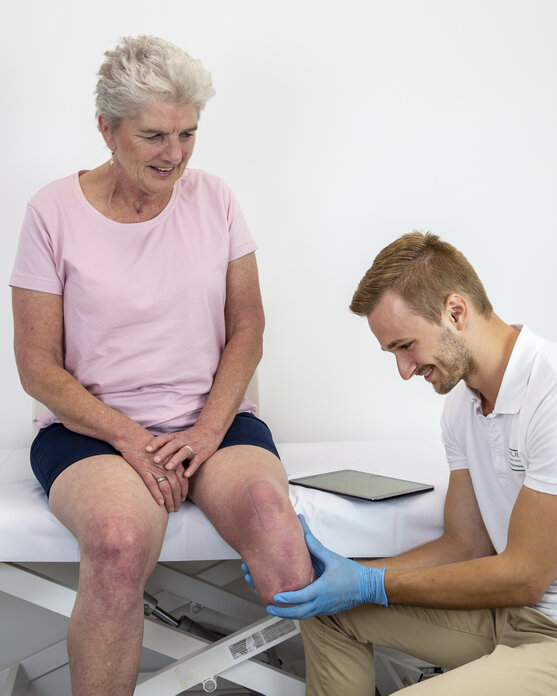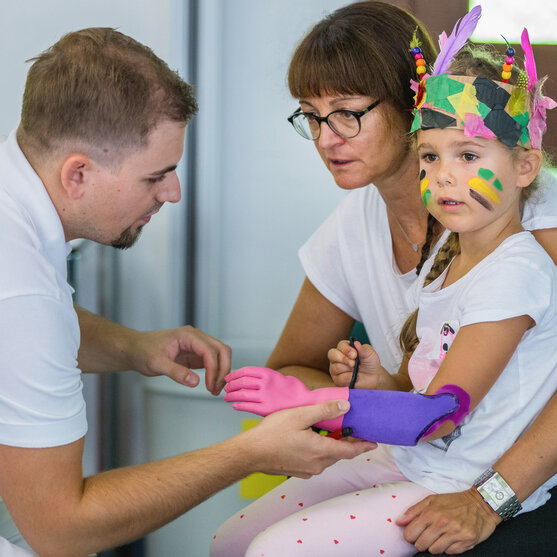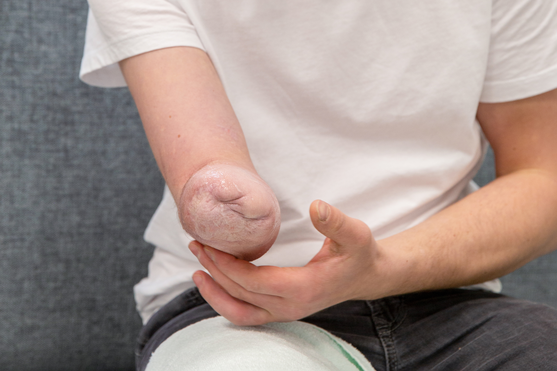Wound healing, compression, prosthesis
Treatment process after amputation
In an amputation, a part of the body is surgically removed. This may be necessary as a result of an accident or due to pre-existing conditions. Common causes of amputation include vascular disease, diabetic foot syndrome (DFS), tumor disease and infection.
At the latest after the amputation, the question arises for every patient: "What happens next?". What your life will look like in the future depends very much on yourself, your perseverance and motivation.
But you are not alone: As orthopedic technicians, we help you - together with your doctors and physiotherapists - to compensate for the loss of your body part with a prosthesis in the best possible way. It is ideal if your doctor contacts us before the amputation. We can then clarify with him or her what needs to be considered during the operation in order to create the best possible conditions for the subsequent prosthesis fitting.


Immediately after surgery, the healing of your residual limb is the top priority. A good recovery is the prerequisite for the subsequent rehabilitation and prosthetic fitting. Swelling of the residual limb is quite normal at the beginning and usually goes down after a while. To counteract possible edema (accumulation of fluid in the tissue), the residual limb is already treated in the hospital with compression bandages or a post-operative liner. This compression treatment is also continued in rehab.
The care process after an amputation can take up to three quarters of a year in total. Once your residual limb has healed, we will fit you with your prosthesis. The preparations for this can take place on site in the hospital or after the hospital stay at a Pohlig location.
We first advise you on the various options and decide together which prosthesis suits you best.
The choice of your prosthesis depends on different factors. In addition to the question of the level of the arm or leg at which the amputation was performed, your health condition, your physical fitness, your home environment, and your professional requirements all play a role in the considerations.
First, we make you an interim prosthesis /preparatory prosthesis), which serves, among other things, early mobilization and further reduction of residual limb edema. Once the residual limb has found its final shape and strength, which takes about 3-6 months, we fit you with your final prosthesis, the so-called definitive prosthesis.
Once your definitive prosthesis has been completed after several fitting appointments, our physiotherapists will train you in the actual use of the prosthesis in everyday life.
Since the prosthesis must be adjusted regularly due to weight gain or loss or due to growth, we will accompany you - if you wish for the rest of your life - and are available to answer all your questions about your prosthesis.

After a finger, hand or arm amputation, a prosthesis can replace the most important basic functions of the missing limb (e.g. opening and closing of the hand) and restore the external appearance.

Foot, leg and hip prostheses can significantly restore your mobility. Immediately after amputation, it makes sense to talk to your orthopedic technician, who will explain the process of prosthesis treatment.
At what level is the amputation performed?
Amputation level
The amputation level describes the point at which a body part is amputated. It is determined by the doctor depending on the respective diagnosis. In addition to many other factors, the amputation level determines the subsequent prosthesis. This is because, depending on the level, more or fewer body parts and joints have to be replaced by the prosthesis.
If it is a planned operation, your orthopaedic technician should be involved in the pre-operative discussion. Together with you and your physician, he or she can clarify which amputation level is best suited for the subsequent prosthesis fitting in your specific case.
We will give you an overview of the different amputation types and heights:

Upper extremity amputation
- amputation of the long fingers up to and including the joint line of the distal interphalangeal joint
- amputation of the long fingers up to and including the joint line of the proximal interphalangeal joint
- amputation of the long fingers up to and including the joint line of the metacarpophalangeal joint
- amputation of the thumb up to and including the joint line of the metacarpophalangeal joint
The hand is basically divided into longitudinal and transverse amputations. The longitudinal amputation affects the fingers, metacarpals and carpus simultaneously, while the transverse amputation is performed horizontally.
- transcarpal amputation (amputation in the carpal rows)
- longitudinal amputation
- wrist disarticulation (entire hand is amputated at the joint)
- forearm amputation (long, medium, short, ultra-short)
- disarticulation in the elbow joint (amputation in the elbow joint. The upper arm usually remains completely intact)
- upper arm amputation (long, medium, short, ultra-short)
- shoulder disarticulation (surgical separation of the entire arm from the shoulder joint)
- shoulder girdle amputation (amputation in the shoulder girdle)
- forequarter amputation (amputation of arm, scapula and clavicle)
Lower extremity amputation
A foot amputation includes over 12 different amputation levels: from toe amputations to midfoot amputations to tarsal amputations.
A below-knee amputation is performed below the knee joint, and sometimes the fibula is completely removed. The function of the knee joint is completely preserved.
In a knee disarticulation, the leg is removed at the knee joint. The thigh is retained, usually with the kneecap.
A transfemoral amputation is performed above the knee joint. It can be performed along the entire length of the thigh.
A distinction is made here between hip disarticulation (leg is removed at the hip joint), hemipelvectomy (leg is removed with the associated pelvic half), and hemicorporectomy (entire lower half of the body is removed).

Let yourself be inspired! We accompany many interesting patients during their Pohlig appointment and give you personal insights.

For those who want to delve even deeper into the matter, we have a suitable video for almost every supply area.

Take a look behind the scenes at Pohlig and find out about diagnoses and our innovative aid solutions!

